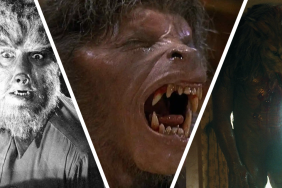
“Whoever is bitten by a werewolf and lives becomes a werewolf himself.” – Maleva, The Wolf Man
Feral. Mangy. Hungry and cursed. No wonder why the werewolf is such a irritable beast. He (or she) has had a hell of an on-screen romp full of ups and downs over the last century. More often than not, we can cite the successful werewolf films by heart; the go-to titles being, arguably, The Wolf Man, An American Werewolf in London and The Howling – that last title spawning a series of abysmal sequels that seemingly set out to destroy the werewolf sub-genre with an unwavering obsession equal to that of Calvin Lockheart’s in The Beast Must Die. Nevertheless, the werewolf has endured.
If Frankenstein’s creation was the misunderstood monster, then the werewolf is without a doubt the misrepresented one. In the hands of an incapable filmmaker, lycanthropy can become a campy joke, no scarier than a retriever playing a game of fetch. In the eyes of special effects artists lacking vision, these hirsute creatures – and the transformation they undergo – can become silly and shaggy behemoths with claws. But some storytellers have gotten it right, recognizing the inner conflict of the afflicted man at the heart of their tale, furthermore the beast that lurks within, and used that to drive themes of adolescence, friendship, sexuality, disease or, of course, the fear of death. If the werewolf is simply used as a killing machine, then some directors have utilized this scenario with at least some imagination.
With The Wolfman upon us this month, I’ve compiled a timeline of significant werewolf moments or notable werewolves who have run amok on the big and small screen. In some entries below you’ll find assorted links to clips featuring transformations, trailers and music videos.
1913 – The First Onscreen Werewolf The white man feels the bite of The Werewolf in Henry MacRae’s silent short film. Based on the story by Henry Beaugrand, a young Navajo woman, fueled by vengeance, turns into a beast to torment invading settlers. The film is destroyed in a fire which means you’re never going to see it. Unfortunate, because the transformation sequence apparently used a real wolf, because back then they were crazy like that…and they didn’t have computers to screw it all up.
1935 – Universal’s First Wolf Man Henry Hull plays the Werewolf of London, Dr. Glendon (a role once considered for Bela Lugosi), who’s on an expedition in Tibet and gets the lycanthrope whammy put on him when he’s attacked by a hirsute creature. Jack Pierce’s wolf man make-up is minimal but effective with its overgrown eyebrows and sharp widow’s peak (Hull didn’t want too wear too many appliances). The transformation is also inspired: Director Stuart Walker filmed Hull’s change from man to wolf as the character walked by a series of columns. (WATCH THE TRAILER)

1943 – Monster Battle Royale Actually, that’s overstating it, especially in the case of Frankenstein Meets the Wolf Man as the beasts don’t tussle until the very end (and when they do, it is admittedly fun). Still, this pseudo-sequel to Waggner’s Wolf Man finds Chaney’s Larry Talbot harboring a death wish. His journey sends him looking for Dr. Frankenstein’s notes. He finds the Monster (played by Bela Lugosi) imprisoned in ice, but it isn’t long before the stitched up creature is revived and…3, 2, 1…FIGHT! (WATCH THE TRAILER)
1946 – Where Wolf? Jean Yarbrough’s She-Wolf of London isn’t a werewolf film at all, but a murder mystery. Although Lost in Space‘s June Lockhart believes she’s been afflicted with lycanthropy.
1948 – “I’m sort of a wolf myself.” Chaney plays it straight as Talbot once again in Abbott and Costello Meet Frankenstein and he’s out to stop Dracula’s plans of dropping a new brain into the Frankenstein Monster’s noggin’. Chick and Wilbur (Bud Abbott and Lou Costello, respectively) inadvertently get mixed up in this scheme. Laughs ensue. Classic Wolf Man moment? Wilbur lifts a piece of fruit from Talbot’s hotel room; in a moment of guilt he returns the food and narrowly avoids getting mauled.
1957 – Dig It Daddy-O Popular teen fodder for the hipsters, drag racers and rebels without a cause arrives in the hit I Was a Teenage Werewolf. Highway to Heaven‘s Michael Landon stars as a representation of angst-ridden youth experimented on to the point where he becomes a werewolf thanks to Phillip Scheer’s make-up. I Was a Teenage Werewolf will later go on to be a popular tune by The Cramps.

1964 – The Attack of Eddie Munster What do you get when you mate a Frankenstein monster with a vampire? A werewolf, according to The Munsters. Yes, television’s lil’ Eddie is the son of Herman and Lily Munster. How is this biologically possible? I don’t know. Just roll with it.
1966 – Housewives’ Early Twilight Fix Dark Shadows Dan Curtis’ supernatural soap opera features all creatures under the sun, er, moon, including werewolves.
1967 – The Werewolf is a Happy Drunk Rankin and Bass depart from the yuletide cheer that permeated their stop motion-animated television classics like Rudolph the Red-Nosed Reindeer and Frosty the Snowman for Mad Monster Party. Although the story’s main focus is a bumbling wet rag named Felix Flankin, every famous monster is represented including the Wolf Man, credited as “The Werewolf.” Although he doesn’t have much to do.
1968 – The Waldemar Daminsky Saga Begins Spain’s Paul Naschy kicks off a fourteen-film streak as the character Waldemar Daminsky with Las Noches del Hombre Lobo (Nights of the Wolfman). As the cursed nobleman, Naschy runs across sundry horror icons (from vampires to Dr. Jekyll and Mr. Hyde).

1971 – Sleazy Riders Michel Levesque’s short career in the director’s chair put him behind the wheel of the drive-in mash-up Werewolves on Wheels which combines elements of the biker genre and horror. Viewers, however, are left whimpering with their tail between their legs over the minimal use of “werewolves.”
1974 – The Werewolf Break England’s Amicus Productions asks viewers to participate in The Beast Must Die‘s 30-second William Castle-inspired gimmick during which the film pauses and asks who you think, of the ensemble cast, is the werewolf. Is it Peter Cushing? Michael Gambon? Or perhaps leading man, and hunter, Calvin Lockhart? (WATCH IT HERE)
1981 – Lycanthrope Overload! Movie-goers get hit with a triumvirate of shape-shifting-fueled genre fare leading with Joe Dante’s The Howling, featuring fierce bipedal werewolves by Rob Bottin – too bad it ends on Dee Wallace Stone’s puppy-faced, runny-nosed transformation. Wolfen arrives mid-summer, throwing a New York cop, played by Albert Finney, into a plot involving wolf spirits and shape-shifting. Oh, and a Battlestar: Galactica‘s Admiral Adama running around naked and howling at the moon. Last but not least, there’s An American Werewolf in London, John Landis’ horror-comedy about two backpackers who are attacked by a werewolf and the curse that afflicts the sole survivor. (WATCH THE HOWLING TRANSFORMATION, JOHN LANDIS TALKS AMERICAN WEREWOLF)

1983 – A Bad Moon Rises Over MTV Landis and Baker re-team for the Michael Jackon video Thriller and the King of Pop is turned into a yellow-eyed were…something. Werecat, Werepanther… Meanwhile, Ozzy Osbourne’s Bark at the Moon is accompanied by a music video that finds the rocker mixing potions in a Victorian set and donning a shaggy werewolf guise by make-up artist Greg Cannom. (WATCH THRILLER IN HD, WATCH BARK AT THE MOON)
1984 – Wicked Fairy Tale Angela Carter co-adapts her short story collection “The Bloody Chamber” with filmmaker Neil Jordan (Interview with the Vampire); the outcome is The Company of Wolves, a sexual, surreal trip with Angela Lansbury, Sarah Patterson, David Warner and wolf snouts sprouting out of human mouths.
1985 – Don’t Try This at Home, Kids! Movie theaters are injected with another healthy dose of lycanthropy. Michael J. Fox is a dork turned Teen Wolf; his van surfing antics are mimicked by dumb-ass kids and reports are issued on the news that parents should advise their children not to copy what they see on screen. The impressionable youngsters instead turn to their local 7-11, walk in and growl, “Give me…a keg…of beer.” Silver Bullet opens in theaters in October. An adaptation of the Stephen King novella, illustrated by Berni Wrightson, Corey Haim plays a wheelchair bound teen who goes on the hunt for a werewolf in his small town. (Trivia: King’s novella came about when Wrightson wanted to team with the author for an illustrated calendar where each month told a chapter. King felt too constrained and expanded the story.) And, the comedy Transylvania 6-5000 opens in November boasting the usual suspects: a vampire, a Frankenstein’s monster and, yes, a wolf man. (WATCH THE SILVER BULLET WEREWOLF TRANSFORM…AND USE A BASEBALL BAT!)
1987 – The Wandering Wolf The Incredible Hulk television formula is applied to Fox’s series Werewolf. John York is the eponymous creature trying to kick his curse. He goes on the road to find the head of his clan and tries to avoid being captured/killed by those who know what he is. The show features FX work of Rick Baker and Greg Cannom and was an early title in the careers of frequent X-Files contributor Rob Bowman and cinematographer Rick Bota (House on Haunted Hill).

1988 – Patrick Macnee Loses His Head The co-star of The Howling (in which he plays a werewolf) not only spends his time in Waxwork rolling about in a wheelchair, but his noggin’ is violently torn off by a lycanthrope. (WATCH THE FULL WEREWOLF SEQUENCE)
1990 – Here Wolf! Universal revisits the 1946 title She-Wolf of London and makes good on its promise to include a “she-wolf” this time. Randi Wallace’s trip to England turns out to be a bust when she’s afflicted with a lycanthropic curse and, like Werewolf, spends the rest of the series searching for a cure while contending with the supernatural. But unlike Werewolf, she does so with a partner, and mythology professor, Ian Matheson. Sparks fly, naturally. Among the contributing writers one will find Mick Garris (The Stand) and Tom McLaughlin (Jason Lives).
1992 – Yet Another Werewolf in London The now defunct Polygram Pictures greenlights John Landis’ An American Werewolf in London II. This time, the story follows Debbie Klein and her pursuit to learn the truth about David Kessler’s death. Nurse Price and Dr. Hirsh are back, as are Jack Goodman and Kessler (in walking corpse form). Landis’ script proves to be too weird for Polygram and the project is put on hold. In theaters, audiences watch Gary Oldman, as Dracula in wolf man form, diddle Sadie Frost on a stone bench in Bram Stoker’s Dracula. Greg Cannom and his make-up FX crew take home an Oscar for their work. On the small screen, Timothy Dalton and Dennis Farina star in a Beast Must Die-inspired episode of Tales from the Crypt entitled “Werewolf Concerto.” Wolfgang Puck plays himself in the episode.
1993 – Kensit & Peebles Do It Doggy Style Mario Van Peebles is enlisted into a squad of werewolf cops that take on drug lords in Full Eclipse. They don’t go full wolf, however. Instead, they sprout fangs and Wolverine-like claws from their fists when they spring into action on the streets…and during lovemaking. Bruce Payne turns total wolf and Tony Gardener’s creation assumes a decided bear-like design. (WATCH THE TRAILER)

1996 – I am Thor Eric Red (The Hitcher) adapts Wayne Smith’s 1992 novel “Thor” which is told from the perspective of a dog who watches a werewolf encroach on his family. The film is released under the moniker Bad Moon (presumably to avoid Marvel’s legal team) and stars Mariel Hemingway, Michael Paré and Mason Gamble. The impressive bipedal beast that rears its mangy head comes courtesy of Steve Johnson’s XFX. Much like the film itself which fluctuates between good and bad, the awesome work by Johnson is counterbalanced by a shoddy transformation. (WATCH IT HERE)
1997 – One Problematic Puppy An American Werewolf in Paris is released Christmas day in the wake of director changes (from Demolition Man‘s Marco Brambilla to Mute Witness‘ Anthony Waller). Written by Freaked‘s Tim Burns and Tom Stern (before plenty of tinkering), the cast is anchored by Julie Delpy and Tom Everett Scott and involves an underground society of lycanthropes in Paris. Werewolves change with the assistance of CGI and intelligence is euthanized in favor of lame comedy. (REMEMBER HOW AWFUL THIS IS?)
1998 – The Slayer’s Hit List Expands Seth Green is introduced to the cast of Buffy the Vampire Slayer as the cursed musician known as “Oz,” a werewolf who hooks up with Alyson Hannigan’s witchy Willow.
2000 – “I’m a God damn force of nature.” Lycanthropy leaps to a female perspective in John Fawcett’s gloomy Canadian production Ginger Snaps. Genre fans drool over star Katharine Isabelle and werewolf cinema is introduced to one ferocious and darkly comedic metaphor for all that applies to teenage girls, from their menstrual cycle to their insatiable budding and curious libido. The film is followed by two sequels, one that takes bold and unusual strides forward and another that lazily steps back for a prequel.

2003 – A Gothic Romeo & Juliet Underworld kicks off a franchise for Screen Gems, pours Kate Beckinsale into tight, black latex and introduces a race of creatures called “Lycans,” designed by Patrick Tatopoulos. Their cat-like maws make them distinct from werewolves and, as fans come to learn in the subsequent sequels, moreover Rise of the Lycans, these creatures, in the Underworld universe, are an offshoot breed of werewolves that can metamorphose from man to beast at will. Lesson over. (MICHAEL SHEEN TURNS INTO A LYCAN)
2004 – Death By Being Pounced On Kate Beckinsale is faced with another hirsute threat in Stephen (The Mummy) Sommers’ second go at the Universal monsters called Van Helsing, starring Hugh Jackman as the eponymous hunter. Here, the Wolf Man transforms, with plenty of CG assist, by tearing his skin off, revealing a hulking wolf beneath. Beckinsale perplexingly bites the big one when she’s tackled by the creature and thrown into a couch.
2005 – Living Up To Its Name Wes Craven and screenwriter Kevin Williamson’s post-Scream deconstruction of another horror sub-genre, Cursed, finally reaches the screen after delays and a re-shooting process that calls for the scrapping of much of its original footage and cast. Both a commentary on relationships in L.A. and werewolf lore, the film shoulders the usual Williamson wink-wink wit and a KNB EFX-created lycanthrope. (WATCH THE TRANSFORMATION)
2006 – Packs Go to War Before he passes away in 2008, special effects guru Stan Winston oversees the creation of the clawed Skinwalkers for director James Isaacs. Here, two packs of werewolves squabble over a child.

2008 – A Hairy Sex & the City Writer-director Michael Dougherty announces he is developing Bitches for Fox. The television series follows a pack of girlfriends coping with relationships and lycanthropy in the big city.
2009 – American Werewolf Redux Dimension Films reveals their intentions of remaking an An American Werewolf in London with Daybreakers producers Sean and Bryan Furst. Universal releases a Blu-Ray presentation of the original Landis film with the feature-length documentary Beware the Moon. Meanwhile, the werewolves of Michael Dougherty’s Trick ‘r Treat push Anna Paquin through a saucy right of passage on Halloween night. The Howling Reborn is announced at the American Film Market. And, Eben McGarr reaches back to the past for House of the Wolf Man co-starring Ron Chaney. (WATCH THE HOUSE OF THE WOLFMAN TRAILER, WATCH THE LADIES OF TRICK ‘R TREAT TRANSFORM)
2010 – Universal’s Beast is Back In spite of its tumultuous development, Universal’s The Wolfman) (now one word instead of two like the original) howls again with Bencio del Toro playing Larry Talbot. Director Joe Johnston takes over directing duties when Mark Romanek walks away from the production weeks before principal photography. Genre fans eagerly await Rick Baker’s latest werewolf work and are curious to see how the transformation is pulled off. (WATCH TRAILERS & TV SPOTS)










